by Martin J. Greenberg and John Wilson
I. Introduction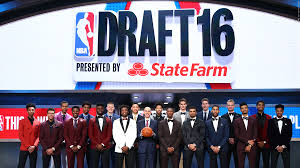
The National Basketball Association (NBA) and the National Collegiate Athletic Association (NCAA) have collaborated on various rule changes with respect to rookie eligibility for the NBA Draft over the past few decades. In 2016, the NBA and NCAA changed eligibility rules once again by extending the NBA Draft opt-out date for athletes that have not exhausted their NCAA eligibility. This article will explore the history of NBA rookie eligibility and the various changes, and then examine how the 2016 rule change affects the NBA, the athletes themselves, and NCAA teams.
II. Who is Eligible for the NBA Draft?
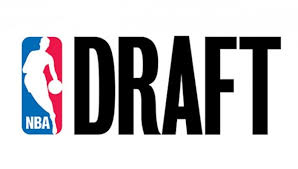 According to the 2011 NBA Collective Bargaining Agreement (CBA), players who have reached age nineteen on or before the calendar year of the NBA Draft, are at least one year removed from the graduation of their high school class, who do not meet the criteria for “international” players, and have not been eligible for multiple Drafts are automatically eligible if they meet any of the following criteria:[1]
According to the 2011 NBA Collective Bargaining Agreement (CBA), players who have reached age nineteen on or before the calendar year of the NBA Draft, are at least one year removed from the graduation of their high school class, who do not meet the criteria for “international” players, and have not been eligible for multiple Drafts are automatically eligible if they meet any of the following criteria:[1]
The player (A) is or will be at least nineteen (19) years of age during the calendar year in which the Draft is held, and (B) with respect to a player who is not an international player (defined below), at least one (1) NBA Season has elapsed since the player’s graduation from high school (or, if the player did not graduate from high school, since the graduation of the class with which the player would have graduated had he graduated from high school); and
(A) The player has graduated from a four-year college or university in the United States (or is to graduate in the calendar year in which the Draft is held) and has no remaining intercollegiate basketball eligibility; or (B) The player is attending or previously attended a four-year college or university in the United States, his original class in such college or university has graduated (or is to graduate in the calendar year in which the Draft is held), and he has no remaining intercollegiate basketball eligibility; or (C) The player has graduated from high school in the United States, did not enroll in a four-year college or university in the United States, and four (4) calendar years have elapsed since such player’s high school graduation; or (D) The player did not graduate from high school in the United States, and four (4) calendar years have elapsed since the graduation of the class with which the player would have graduated had he graduated from high school; or (E) The player has signed a player contract with a “professional basketball team not in the NBA”(defined below) that is located anywhere in the world, and has rendered services under such contract prior to the January 1 immediately preceding such Draft; or (F) The player has expressed his desire to be selected in the Draft in a writing received by the NBA at least sixty (60) days prior to such Draft (an “Early Entry” player); or (G) If the player is an “international player” (defined below), and notwithstanding anything contained in subsections (A) through (F) above: (1) The player is or will be twenty-two (22) years of age during the calendar year of the Draft; or (2) The player has signed a player contract with a “professional basketball team not in the NBA” (defined below) that is located in the United States, and has rendered services under such contract prior to the Draft; or (3) The player has expressed his desire to be selected in the Draft in a writing received by the NBA at least sixty (60) days prior to such Draft (an “Early Entry” player).[2]
A player who declares for the Draft will lose his college eligibility, even if he is not drafted, if he signs with any agent.[3] Before 2016, the NCAA only allowed a player to enter the Draft once without losing eligibility,[4] but current NCAA rules now allow players to declare for and withdraw from multiple Drafts while retaining college eligibility.[5] The CBA, however, allows a player to withdraw twice.[6]
The NCAA adopted a rule that took effect in August of 2009 that required college players to withdraw no later than May 8th to retain their college eligibility; the first Draft affected by this rule was the 2010 Draft.[7] In 2011, the NCAA shortened its timeline for players to withdraw and retain eligibility to one day before the start of the spring signing period for men’s basketball, which occurs in April.[8] The NCAA changed its withdrawal rule again in 2016, effective with the 2016 Draft; the withdrawal deadline is now in late May, specifically ten days after the conclusion of the NBA Draft Combine.[9]
III. High School Draftees: Haywood v. NBA, the 1990s, and Age Restrictions
Prior to the 2005 NBA CBA, players were able to enter the League directly from high school thanks to Spencer Haywood.[10] Haywood was barred from entering the NBA in 1967 due to a rule that stated players could only join the NBA after four years of college.[11] Haywood was a superb amateur basketball player, competing in the 1968 Olympics prior to going to college, and then playing collegiately for the University of Detroit.[12] The NBA rules prevented Haywood from joining a NBA team before his high school class graduated college (or four years after graduating high school), so Haywood signed with an American Basketball Association (ABA) team.[13] When he turned twenty-one years old, he repudiated the contract with the ABA team, charging fraud; and went on to sign with the Seattle SuperSonics (Seattle) of the NBA.[14] Haywood signed with Seattle prior to his high school class graduating college (or “less than four years after his high school class had graduated”), which left him ineligible under the current NBA rule to enter the NBA Draft and play in the NBA.[15] In response, “the NBA threatened to disallow the contract and also threatened Seattle’s team with various sanctions.”[16]
Haywood argued that the conduct of the NBA constituted a group boycott and was a per se violation of the Sherman Act.[17] Haywood “was granted an injunction pendente lite[,] which allowed him to play for Seattle and forbade the NBA to take sanctions against the Seattle team.”[18] The NBA then appealed to the Court of Appeals for the Ninth Circuit the granting of the preliminary injunction.[19] The court stayed the injunction.[20] Haywood then appealed to the Supreme Court, which upheld the ruling of the district court, allowing Haywood to play for Seattle and preventing the NBA from sanctioning Seattle.[21] The decision allowed a significant number of high school graduates and college attendees to make themselves eligible for the NBA Draft before completing four years in college.[22] However, most NBA teams were wary of drafting players right out of high school due to their inexperience.[23]
The 1990s saw several high profile high school basketball players drafted without going to college. “K[evin ]G[arnett] was the first high school player to be selected in the Draft since Bill Willoughby in 1975.”[24] In 1995, the nineteen-year-old Garnett skipped college and was a lottery pick at No. 5 in the 1995 Draft.[25] This opened the gates for Kobe Bryant the next year[26] and Tracy McGrady the year after that.[27] But with a growing gallery of perceived busts, Former NBA Commissioner David Stern and the owners advocated for a rule change to stem the tide.[28] It did not matter that “the pipeline from high school to the NBA would soon deliver [talents like] LeBron James[ and Dwight Howard];” “[owners] lamented what [they] saw as the league’s sinking standard of professionalism.”[29]
Subsequent to “the six month lockout of players that followed the 1998 NBA Finals,” Former Commissioner Stern considered “instituting an age limit on players looking to enter the NBA.[30] Stern and others cited the decline in scoring in the 1999 season compared to the 1997–1998 season” as a rationale for instituting this age limit.[31] However, Stern failed to “note the effects of the dramatic roster changes post-lockout, playing one half of basketball in a shorter time period (the first half of the 1997–1998 season was fourteen weeks long. In 1999, it was twelve weeks),”[32] and did not mention “the decline of the Chicago Bulls following the breakup of their Championship team.”[33] Moreover, “the 1999 Draft only had two high school players taken after three were selected in 1998.”[34]
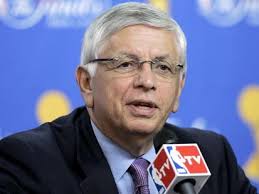 In response, “By 2005, Stern sought to implement an age limit of twenty years old.[35] In addition to his complaints about the style of the game, he wanted to get pro scouts out of high school gyms.”[36] Spencer Haywood, “the [player] who sued the league and opened the door for high school players to enter the league . . . came out in favor of an age limit in the early 2000s.[37] Haywood wanted young players to develop their skills as well as focus on their education.”[38] Several “veteran players [also] made the case for the age limit based on the benefits it would provide players already in the league.”[39]
In response, “By 2005, Stern sought to implement an age limit of twenty years old.[35] In addition to his complaints about the style of the game, he wanted to get pro scouts out of high school gyms.”[36] Spencer Haywood, “the [player] who sued the league and opened the door for high school players to enter the league . . . came out in favor of an age limit in the early 2000s.[37] Haywood wanted young players to develop their skills as well as focus on their education.”[38] Several “veteran players [also] made the case for the age limit based on the benefits it would provide players already in the league.”[39]
However, there was some opposition to this age limit by Billy Hunter and the National Basketball Players Association (NBPA).[40] The NBA and the NBPA “compromised and agreed to an age limit of nineteen years old in June 2005 as part of the [2005 CBA.]”[41]
Under the 2005 CBA, players were not able to play in the NBA unless they were or until they were nineteen years old and one year removed from high school, “but they c[ould] join the Developmental League [(D-League)] at eighteen years old.”[42] The vision for the D-League is that of “a minor league system for the NBA[;]”[43] however, many NBA teams, like the Milwaukee Bucks, do not have an exclusive D-league team affiliate.[44] Therefore, “without a true minor league system, young players do[ no]t have an opportunity to receive consistent coaching and training from teams” along with the time and space to build on their skills in a low-pressure environment.”[45] Players can elect to play internationally after high school instead of going to college, “but only Brandon Jennings and Emmanuel Mudiay,”[46] and Jeremy Tyler[47] have done so and then been drafted.[48]
When the age limit was instituted in 2005, several players voiced their opposition. Bill Walker (who later went on to play at Kansas State) said, “I’m against it. I don’t see why you have to be 19 to play a game of basketball when you can be 18 and go to war for our country and die. It’s ridiculous.”[49] Jerryd Bayless, who went on to play at the University of Arizona, said “It’s not fair at all. If a tennis player can go pro at 13, I don’t understand why a basketball player can’t go pro at 18.”[50] A possible number one daft pick out of high school had the rule not been put in place was Greg Oden who played at Ohio State and was eventually picked first overall in 2007.[51] When asked about the age restriction, he said “It’s unfair, but it’s over with now, so there’s no reason to complain.”[52]
Some players also came out in support of the age limit. Wayne Ellington of the University of North Carolina, said that “. . . I . . . think it’s going to help the league a little bit. Some guys who come in, like from this year’s draft, it will help.”[53] Brandan Wright, also of the University of North Carolina, said that “It may hurt guys who need money, but it will help people grow and develop.”[54]
Union leaders have also come out in opposition to the age limit, despite the fact that they agreed to it in the first place. NBPA Executive Director Michele Roberts said, “I started working when I was 13 in New York . . . I’ve never not worked. I understand that you want to work to support yourself and your family. It offends me that there should be some artificial limits set on someone’s ability to make a living.”[55]
“‘One and Done’ is a slang term used to describe a player who stays in college for a single year before bolting for the NBA” because the NBA requires players to be at least a year removed from high school to be eligible for the Draft.[56] The union argues that “One-and-Done” limits the career earnings of young stars, whose cost-controlled, CBA-regulated rookie contracts now push a year deeper into their physiological prime.[57] With the NBA CBA likely reopening after the 2017 season, both the league and the NBPA are staking out every bargaining chip possible. Roberts is refusing to budge on the “One-and-Done” issue without getting something in return:[58]
I would say that I don’t think it’s ever helpful to say ‘no way, no how’ to any issue. . . . We should stop artificially creating barriers to keep them out. And so I’m disappointed. I don’t know what the union exchange for the 19-year-old age limit [would be] and it may be there is something that my guys would say we will allow for another year. But as a philosophical matter, the union opposes any continued roadblocks to have talented players to be able to come in and earn a living.[59]
IV. International Players
The CBA defines “international players” for draft purposes as those who meet all of the following criteria:
(i) who has maintained a permanent residence outside of the United States for at least the three (3) years prior to the Draft, while participating in the game of basketball as an amateur or as a professional outside of the United States;
(ii) who has never previously enrolled in a college or university in the United States; and
(iii) who did not complete high school in the United States.[60]
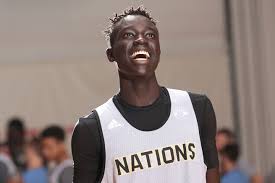 An interesting recent case study regarding international players under the new Draft Rules looks at 2016 Draftee Thon Maker (Maker). Maker was officially cleared by the NBA to enter the 2016 Draft in April 2016.[61] So, “Maker will become the first player to jump straight from high school to the NBA since 2005, when the league established the one-and-done rule.”[62]
An interesting recent case study regarding international players under the new Draft Rules looks at 2016 Draftee Thon Maker (Maker). Maker was officially cleared by the NBA to enter the 2016 Draft in April 2016.[61] So, “Maker will become the first player to jump straight from high school to the NBA since 2005, when the league established the one-and-done rule.”[62]
Maker’s case is unique in that he was born in Sudan, gained refugee status in Australia, and played two years of high school basketball in the United States before transferring to the Athlete Institute in Canada.[63] “Maker was born in February of 1997 and, according to his guardian, graduated high school in June of 2015, despite staying at the Athlete Institute in Ontario, Canada for a fifth year of high school.”[64] The NBA, in allowing him to enter the 2016 Draft, “d[id no]t change the rule that, in order to be eligible, a player has to be at least nineteen years old and one year removed from high school.”[65] Maker was drafted by the Milwaukee Bucks in the first round of the 2016 Draft.[66]
V. One-and-Done: Pros, Cons, and Future Viability
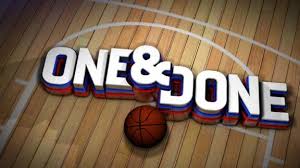 While players are no longer able to make the jump directly from high school to the NBA — (unless they are involved in a unique situation like Maker’s) — most elite high school players enroll in college for one year and then leave for the NBA. This type of strategy is called “One-and-Done” and it has had an immense impact on both college recruiting as well as NBA Draft strategy.
While players are no longer able to make the jump directly from high school to the NBA — (unless they are involved in a unique situation like Maker’s) — most elite high school players enroll in college for one year and then leave for the NBA. This type of strategy is called “One-and-Done” and it has had an immense impact on both college recruiting as well as NBA Draft strategy.
Some notable “One-and-Done” players include Anthony Davis (Kentucky),[67] Kevin Durant (Texas),[68] Greg Oden (Ohio State),[69] Derrick Rose (Memphis),[70] and Kevin Love (UCLA).[71] While these players only stayed in college one year,
their talent helped the NCAA and the NBA. The [NBA] earned an additional year to evaluate prospects. But the future pros also justified the NCAA’s $10.8 billion price tag for the NCAA tournament as part of a fourteen-year television deal with CBS and Turner Sports that was signed in 2010.[72]
Since the age limit restriction took effect, the presence of “One-and-Done” players “has shifted the collegiate game” to one where many dominant players compete only as freshmen.[73]
For example, “Kevin Durant won the Naismith Award following the 2006–07 season.[74] Greg Oden led Ohio State to the national title game the same year.[75] Derrick Rose took Memphis to the national championship game in 2008.”[76] In 2012, “Kentucky leaned on three freshmen (Anthony Davis, Michael Kidd-Gilchrist, and Marquis Teague) to win the national title.[77]
The One-and-Done Rule has given college basketball some high profile players including “Kevin Durant, Greg Oden, Derrick Rose, Kevin Love, Michael Beasley, John Wall, and DeMarcus Cousins” who impacted the college game for only one year.[78] “In 2010, the media made Harrison Barnes the first freshman preseason Associated Press All-American in college basketball history”[79] (although Barnes played at the University of North Carolina for two seasons and was not a “One and Done”). Three more freshman “One and Done” players have since made the preseason Associated Press All-American team: Andrew Wiggins, Jahlil Okafor, and Ben Simmons.[80] “And only once in the decade since [One-and-Done started] — in 2009, when Oklahoma sophomore Blake Griffin went to the Clippers — has a one-and-done freshman not been the No. 1 overall Draft pick.”[81]
Players are divided on the issue of “One and Done” as well, as mentioned above, with many players seeing the benefits of the age restriction for the NBA Draft and still many other players who view the age restriction and “One and Done” rule as affecting their potential earnings and cutting their NBA careers short. One such player who has been vocally against the “One and Done” rule is former Louisiana State University (LSU) Star Ben Simmons (Simmons). In his new Showtime Sports documentary, Simmons, who was the number one overall pick by the Philadelphia 76ers in the 2016 NBA Draft after just one year at LSU, blames the NCAA for wasting his lone year of college by asking him to attend class.[82] “Everybody’s making money except the players. We’re the ones waking up early as hell to be the best teams and do everything they want us to do and then the players get nothing. They say education, but if I’m there for a year, I can’t get much education.”[83]
There has not been a consensus among college coaches on the benefits of the NBA’s age requirement either.[84] There are coaches who find the requirement “problematic.”[85] For example, Duke Head Men’s Basketball Coach Mike Krzyzewski feels that one-and-done players has created and added to “instability” in college sports in recent years.[86]
“What it has produced is one-and-done for kids who are not going pro, the amount of transfers we have in basketball. There are over 450 transfers. Kids don’t stick to the school that they pick and they want instant gratification . . . It’s not just those elite players that might be able to go after one year. There’s just the mentality out there that if you don’t achieve after one year, maybe you should go someplace else. For the one-and-done guys it’s the NBA, but for the other kids, it’s another school.”[87]
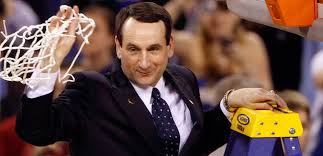 Krzyzewski also added, “if you have to go for one year, I may be placing you in a situation you don’t want to be in. What courses do you take? Do you go to school in the second semester? Do you ever unpack your bags?”[88] However, “in 2015, [Jahlil] Okafor, Justise Winslow, Tyus Jones, and Grayson Allen scored sixty of Duke’s sixty-eight points in the Blue Devils’ national title win over Wisconsin, the most ever by freshmen in an NCAA championship game.[89] A few weeks later, Okafor, Winslow, and Jones entered the NBA Draft.”[90] Okafor, Winslow, Jones, and Allen were all freshman.
Krzyzewski also added, “if you have to go for one year, I may be placing you in a situation you don’t want to be in. What courses do you take? Do you go to school in the second semester? Do you ever unpack your bags?”[88] However, “in 2015, [Jahlil] Okafor, Justise Winslow, Tyus Jones, and Grayson Allen scored sixty of Duke’s sixty-eight points in the Blue Devils’ national title win over Wisconsin, the most ever by freshmen in an NCAA championship game.[89] A few weeks later, Okafor, Winslow, and Jones entered the NBA Draft.”[90] Okafor, Winslow, Jones, and Allen were all freshman.
On the other hand, Former University of Texas head men’s basketball coach and current University of Tennessee Head “[C]oach Rick Barnes . . . sees positives for college basketball. He cited former Texas standout Damion James as a player who benefited from the NBA’s minimum age requirement for Draft entrants.”[91]
Barnes noted that “James may have considered going to the NBA right after high school without the rule. And that would have been a mistake.”[92] Instead of going straight to the NBA, “his first year in Austin helped him assess his true NBA stock. James ultimately stayed for four seasons before the Atlanta Hawks drafted him in the first round of the 2010 Draft.”[93]
The real argument for an age limit is rooted in economic self-preservation. “Unlike football, baseball, and soccer, basketball is a five-on-five game wherein one star player can singlehandedly elevate a billion-dollar franchise or one costly underachiever can entomb it.”[94] In fact, “Nothing in sports is more valuable than an NBA first-round pick,” one league source points out.[95] “The bigger a prospect’s résumé, and the better his competition, the easier it should be for teams to avoid investing millions into a bust.”[96] There is no consensus on whether the age limit should be increased, but the NBPA is against such a measure.[97]
The NBA’s “current Commissioner Adam Silver believes players would be better served, both from a physical and emotional maturity perspective, if they stayed in school longer, and has expressed interest in raising the minimum age to twenty.”[98] As would be expected, “players dislike the rule because it limits their ability to choose when to make the jump into the NBA.[99] Some even see the policy as racist.”[100]
VI. 2016 Rule Change – Mutual Benefits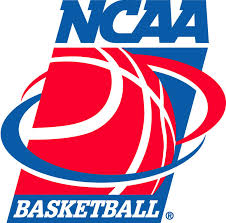
From 2009–2015, any collegiate underclassman who made himself eligible for the NBA Draft and appeared on the NBA’s official early-entry list lost his college eligibility.[101] The NCAA eliminated the ability of underclassmen to test the waters and withdraw from the Draft, meaning the list NBA teams received at the end of April of each year was, for all intents and purposes, the pool of college players they would be choosing from.
Because this was an NCAA rule as opposed to an NBA rule, international players outside the U.S. could still withdraw ten days before the Draft.[102] The collegiate student-athletes who entered the Draft had no other realistic recourse but to stay in the Draft and hope for the best.
The NBA’s deadline for student-athletes to enter the Draft in the first year of the rule change was April 29, 2016.[103] However, if underclassmen declared for the Draft between April 11 and 29, 2016, they would have relinquished any remaining college eligibility.[104] This timeline is due to a rule adopted by NCAA member schools in 2011.[105] The rule change was designed to help student-athletes make a decision earlier than in the past to focus on either academics or athletics and also give coaches more flexibility with roster-planning and recruiting.
In March of 2015, following a series of meetings that began at the 2014 men’s Final Four, the NBA, NCAA, and the National Association of Basketball Coaches (NABC), the trade association for college men’s coaches, announced a plan that would give college underclassmen a better opportunity to make an informed decision about their NBA status than the then-current system.[106] Under this plan, the NCAA would no longer automatically treat entry into the Draft as forfeiture of remaining college eligibility.[107] Instead, the NCAA would allow underclassmen to withdraw from the Draft in late May, about five weeks after the then-current deadline and retain their remaining eligibility unless they signed with an agent.[108] The NBA’s early-entry and withdrawal deadlines, respectively sixty days and ten days before the Draft, would not change because they are written into the league’s current CBA.[109]
“In past years, any college basketball player with remaining eligibility effectively had to decide to turn pro by early April.”[110] The NBA Draft Combine is held each May before the June NBA Draft and “is a multi-day showcase.”[111] At the NBA Draft Combine, athlete attendance is by invitation only, and athletes are involved in such things as measurements, interviews, shooting drills, medical testing, and other forms of drills and athletic testing that are of interest to NBA coaches, general managers, and scouts who are in attendance.[112] “[The] athletes’ performance during the combine will have an effect upon the athletes’ draft status, salary, and ultimately the athlete’s career.”[113] Under the old rule, a player could only participate in the scouting Combine, work out for teams, and receive feedback on how NBA front offices valued him if they made this declaration, effectively cutting off the safety net of the NCAA.[114] “If the player fared poorly or was projected as a late pick, it was too late: his decision to leave college was final.”[115]
In January of 2016, “the NCAA’s Division I Council adopted a proposal that allowed players an extra five weeks upon declaring for the draft to make up their mind withdraw their names.”[116]
In response, the NBA expanded its invitation-only Draft Combine, currently held in Chicago, to include players with remaining college eligibility (who would also have to be invited in order to attend).[117] The stated purpose of this expansion was to allow underclassmen to receive feedback from NBA teams on their Draft prospects.[118] According to one NCAA executive, the expanded Combine would involve from twenty to thirty percent more players than the sixty-five to seventy who participated at that time.[119]
The NCAA rule change was formally presented by the NCAA Men’s Basketball Oversight Committee on June 24, 2015,[120] and was approved by the NCAA Division I Council on January 13, 2016.[121] The new rule, which took effect in the 2016 Draft, specifically set the new withdrawal date at ten days after the end of the NBA Draft Combine.[122] Additionally, players may declare for the Draft multiple times without losing college eligibility, as long as they withdraw before the new deadline without hiring an agent, and will be allowed to attend the Draft Combine and one NBA team tryout per year without losing college eligibility.[123]
Below is a breakdown of the new rules that went into effect starting the spring of 2016:[124]
- The NCAA will allow college basketball players to enter and withdraw their names from the NBA Draft an unlimited amount of times over the course of their four-year careers. It’s important to note that the NBA has its own rule, which it may elect to change in the next CBA with the players association. It states that non-automatically eligible Draft prospects, which doesn’t include 1994-born international players or NCAA seniors, can only withdraw from the Draft twice and become automatically eligible in the next Draft following their second time withdrawing. Both rules combined mean players can be in the Draft up to three times, following their freshman, sophomore, and junior seasons, or as a sophomore, junior and senior.[125]
- NCAA underclassmen are permitted to attend the NBA Combine and participate in one private workout at each of the 30 NBA team facilities.[126]
- NCAA underclassmen who are invited to the NBA Combine are allowed to work 12 hours per week with their college coaching staff at their home facility to help prepare.[127]
- NCAA underclassmen have until May 25 (ten days after the NBA Combine) to withdraw their names from the NBA Draft and keep their college eligibility. International players will continue to follow the NBA deadline, which is ten days before the NBA Draft.[128]
In 2016, the NBA Draft Combine ran from May 11–15 in Chicago.[129] Prospects with remaining collegiate eligibility were allowed to attend the Combine and go through one team workout before making their decision.[130] They could do this as many times as they want.[131]
The previous declaration date was the day before the start of the spring National Letter of Intent signing period in April, while the NBA Draft Combine is typically held in mid-May.[132] This arrangement benefited college coaches, but was not favorable to players because they needed to make up their minds before being properly evaluated by NBA teams.[133] Now, they can at least go through the beginning of the Draft process before making the ultimate decision to forego their college eligibility.
VII. How the Change Affects the NBA
“The new rules have far-reaching implications, but NBA scouts and executives . . . are split firmly into two separate[ and polar ]camps.”[134]
The first camp includes
those who liked the old way [and] appreciated having a set list of draft-eligible collegiate underclassmen on April 30th of each year.[135] Players would hire agents relatively quickly and the lines of communication would be clear and open for doing all the necessary work required to prepare for the Draft. Teams would then have nearly two full months to conduct private workouts, watch film, gather background info, study the players’ medical history, and perform psychological testing.[136]
Very few NBA workouts would be conducted in May because agents prefer to host their players at private workout facilities to get them ready.[137]
Agents of prospects projected to go in the lottery would have no interest in visiting with teams until they knew the exact order of the NBA Draft, which was set in mid-May.[138]
Now things have changed. “NBA teams consider themselves to be embroiled in an arms race to collect as much information as possible about every player. Some NBA teams may elect to bring hundreds of players into their facilities, fully knowing many of them will withdraw from the draft.”[139] NBA executives are interested in this information for both their 15-man rosters as well as their D-League rosters.[140] “Because every player on a NCAA roster could theoretically be eligible for the draft, it’s important to cast a much wider scouting net and make sure scouts and executives have firm opinions on younger prospects who may one day develop into NBA players.”[141] Other teams could play “wait-and-see” until May 25th, when underclassmen were forced to make a decision.[142]
VIII. Effects on College Recruiting
It remains to be seen how this rule change will affect the college recruiting cycle. The team that would appear to be most affected by this rule change is the haven for “One-and-Done” players: the University of Kentucky Wildcats.
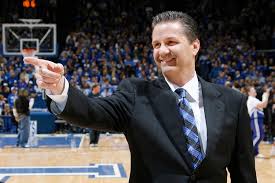 However, Kentucky Head Men’s Basketball Coach, John Calipari, is unsure how this rule will ultimately affect his recruitment.
However, Kentucky Head Men’s Basketball Coach, John Calipari, is unsure how this rule will ultimately affect his recruitment.
“I think it’s good for the game,” Calipari said. “It’s good for the student-athletes. You hate for a young man to start his career and be told one thing and you know it’s not true. And you look at him like, ‘Why?’ . . . Now you’re hearing it from GMs, player personnel directors, the NBA – they can say, ‘You need to go back to school. . . . This will give those kids the opportunity to know (the truth).”[143]
In his past six recruiting classes, twenty-five of Calipari’s thirty-two signees have signed with Kentucky during the early period in November, months before current players make their NBA decisions public, meaning the new rule will likely have little to no effect on his recruitment.[144]
Zachary Zagger argues that
the rule changes will create some uncertainty for college coaches and could also adversely affect incoming recruits as they may not know whether some of the players they are looking to replace are returning to school or entering the Draft at the time they can sign their National Letters of Intent.[145]
He argues that “the rule clearly benefits the current players.”[146]
Some college coaches feel the rule could still provide more benefits to current college athletes.
Villanova head coach Jay Wright is proposing for underclassmen to have access to agents during the draft process. As of now, coaching staffs and families are responsible for scheduling workouts and interviews with teams and travel expenses. However, I feel if there were to be an addendum added to the new draft rules it could lead to confusion in understanding of these new rules. The NCAA and Commissioner Silver adjusting the draft eligibility rules is a step in the right direction. To think of changing them again so soon could possibly change the relationship between the NBA and the NCAA once again after finding an area of common ground.[147]
IX. How the Change Affects the Athletes
Cody McDavis (McDavis), a member of the NCAA’s Division I Men’s Basketball Oversight Committee, commented that
“[t]he rule is a good idea because it provides men’s basketball student-athletes the opportunity to test their dream of going beyond the stage of amateurism into the professional level without completely sacrificing their collegiate career, should they find they are not as prepared as they had hoped for the next level.”[148]
If a player leaves college too early, a late draft position—or none at all—could force a player to compete overseas or in the NBA D-League, where he might not receive the same quality of development or the high profile that a strong college program could offer.[149]
McDavis also added,
“[The rule allows] student-athletes to realize their dreams without punishing them for having such dreams. Almost every men’s basketball student-athlete has dreamt of playing in the NBA. This proposal allows them to attempt to make those dreams a reality without taking away their ability to come back and play in amateur collegiate sport if they happen to be unsuccessful.”[150]
The rule, recommended by the Men’s Basketball Oversight Committee, is the result of extensive collaboration among the NCAA, NBA, and the National Association of Basketball Coaches, which worked together to provide more flexibility for men’s basketball student-athletes with professional aspirations.
Regarding the rule change and whether student-athletes should make the leap to the NBA early, NBA Executive Vice President for Basketball Operations, Kiki Vendeweghe, stated,
“the longer you stay in school and play, the more information we would have about you. The more you would be scouted, the more familiar we would be with your game, the better predictor you can have for success – keeping in mind these draft picks are worth millions of dollars.”[151]
Dan Guerrero, chair of the NCAA Men’s Basketball Oversight Committee and Athletic Director at the University of California, Los Angeles, said the new rule will provide students with the most information possible to help them make informed decisions:[152]
“The cooperation between the NCAA, NBA and NABC was vital to the success of this idea. We reached an excellent outcome that will undoubtedly benefit every group involved, most importantly the student-athlete . . . We all worked toward the same goal – providing students and their families with the opportunity to assess their future professional sports prospects in a realistic timeline. The rule change will allow students the chance to pursue their dreams while still preserving their ability to play collegiately.”[153]
Jim Haney, Executive Director of the Nationals Association of Basketball coaches said that “It’s really student-athlete-friendly.”[154] Haney continued that the stricter policy originally in place “was meant to help coaches know with certainty what their roster would look like for the next year, but the reality is, it wasn’t helping kids make informed decisions.”[155]
Beginning with the 2016 NBA Combine, “the NBA will invite a select number of draft-eligible players to the NBA Combine, which will provide a good indicator of an underclassman’s draft potential.[156] Following the Combine, the NBA will provide specific feedback.[157] Students can also work out for one NBA team to provide additional assessments.”[158] Another impact of the new rule is that “a student invited to the Combine will be allowed to work out with his college coaches from the time he receives his invitation until he withdraws from the Draft.[159] Workouts will be kept to the in-season limit of four hours a day for up to twenty hours per week.”[160]
Typically, “in late April and May, men’s basketball student-athletes are limited to eight hours per week of skill instruction, conditioning and film review, not to exceed two hours of skill instruction.[161] Practice is prohibited surrounding final exams.”[162] McDavis believes “that the limit on the number of students invited to the NBA-sponsored Combine will likely encourage many uninvited students to return to school, particularly when paired with the new flexibility.[163]
“I am of the belief that a student-athlete who does not receive an invite to the draft or an invite to work out with a team will make the smart decision to return back to college to continue to grow as a player. [. . .] However, should they receive an invite, they will have an opportunity to compete against draft-potential competition and receive feedback on their performance. Either way, they have an opportunity to make an educated decision that is best for them and their family. That is why this is so important.”[164]
The new rule reverses the 2009 decision that moved the withdrawal deadline for athletes considering the Draft to the day before the spring signing period in April.[165] Although this new rule may affect roster planning and may make it “more difficult for coaches who will have to wait until as late as May to know whether their top players are returning to school, coach support through the NABC was critical.”[166]
Bill Self, University of Kansas Head Men’s Basketball Coach, said the rule provides immeasurable benefits to student-athletes: “this legislation, with help from the NBA, will allow student-athletes the opportunity to make informed decisions on their true status as a draft prospect before forfeiting their collegiate eligibility.”[167]
Under the current rule, “a student-athlete, his or her parents or the university’s professional sports counseling panel may negotiate with a professional sports organization without the loss of the student-athlete’s amateur status.[168] However, a student-athlete who retains an agent will lose amateur status.”[169]
At the current time,
the NCAA is reviewing its current agent and advisor legislation to ensure that student-athletes have the best information at the right time to make informed decisions.[170] The NCAA is not likely to change its opposition to student-athletes receiving benefits from agents and advisors, but will discuss how advisors might help provide information to student-athletes who are weighing their professional options.[171]
X. First Draft After the Rule Change – Findings
The notable difference in the Draft as affected by the rule change is the number of withdrawn early entrant candidates. In 2016, over half of the early entrant candidates withdrew from consideration prior to the deadline, a notable increase over years past.[172] The rule change ultimately did not have an effect on the number of underclassmen taken in the Draft, which was consistent with the numbers from the past five years. The following chart tracks the NBA Draft Results since 2012:[173]
| Early Entrant Candidates | Early Entrants | Freshmen Drafted | Sophomores Drafted | Juniors Drafted | Seniors Drafted | Intl. Draftees | D-League Draftees | |
| 2012 | 67 | 56 | 9 | 13 | 8 | 21 | 9 | 0 |
| 2013 | 78 | 60 | 8 | 8 | 12 | 18 | 13 | 1 |
| 2014 | 75 | 57 | 9 | 11 | 8 | 17 | 13 | 2 |
| 2015 | 91 | 58 | 13 | 8 | 8 | 17 | 14 | 0 |
| 2016 | 162 | 72 | 14 | 10 | 5 | 15 | 16 | 0 |
While the rule change certainly allowed players to get a better sense of their stock and offered some the chance to return to school rather than go undrafted, the process still yielded more early entrants – a group that included 17 freshmen, 17 sophomores and 25 juniors – and more undrafted underclassmen than ever before.[174]
NCAA Vice President of Men’s Basketball Championships Dan Gavitt maintained before the draft that the new policy was a success.[175]
“There is no question that some underclassmen benefitted from the process. Both some that decided to stay in the draft and some who came back – who clearly, in my mind, would not have come back had they had to declare in April and that was the last opportunity they had.”[176]
It is unclear how this rule will affect all parties involved going forward. However, one of the goals of the new rule was to get college athletes to make smarter decisions regarding their professional athletic futures, and it appears the rule change has accomplished this goal as evidenced by the high number of early entrant candidates who withdrew from the NBA Draft in the first year of the rule’s implementation.
John Wilson is a graduate of Marquette University Law School. He received his Juris Doctor in 2016. Wilson is also a 2016 Sports Law Certificate recipient at Marquette through the National Sports Law Institute. During his law school tenure, Wilson was a staff member of the Marquette Sports Law Review (Volume 26), and was inducted into the Pro Bono Honor Society at Marquette. Prior to Marquette, Wilson earned his Bachelor of Arts in Communications and Film Studies from DePauw University.
[1] NBA Collective Bargaining Agreement, art. X (2011) [hereinafter NBA CBA].
[2] Id.
[3] 2010–11 NCAA Division I Manual art. 12.3.1 (2010) [hereinafter NCAA Manual]
[4] Id. art. 12.2.4.2.1.1.
[5] Jeff Goodman, College Players Given Extra Time to Mull NBA Draft Decision, ESPN (Jan. 13, 2016), http://espn.go.com/mens-college-basketball/story/_/id/14564613/date-nba-draft-commitment-pushed-may.
[6] NBA CBA, supra note 1, art. X, § 8(c).
[7] NCAA Manual, supra note 3, art. 12.2.4.2.1.1(a); Eammon Brennan, The New NBA Draft Deadline is Ridiculous, ESPN (Apr. 29, 2011), http://espn.go.com/blog/collegebasketballnation/post/_/id/30366/the-new-nba-draft-deadline-is-ridiculous.
[8] AP, NCAA Makes Rules Changes, ESPN (May 1, 2011), http://www.espn.com/college-sports/news/story?id=6444510.
[9] Goodman, supra note 5.
[10] See Haywood v. Nat’l Basketball Assoc., 401 U.S. 1204 (1971); see also Brian Fleurantin, The NBA Draft Age Limit 10 Years Later, SB Nation: Nets Daily (June 27, 2015), http://www.netsdaily.com/2015/6/27/8855223/the-nba-draft-age-limit-10-years-later.
[11] Haywood, 401 U.S. 1204.
[12] Id.
[13] Id. at 1204–05.
[14] Id. at 1205.
[15] Id.
[16] Id.
[17] Id.
[18] Id.
[19] Id. at 1206.
[20] Id. at 1206–07.
[21] Id.
[22] See generally Fleurantin, supra note 10; see also generally William C. Rhoden, Early Entry? One and Done? Thank Spencer Haywood for the Privilege, N.Y. Times (June 29, 2016), http://www.nytimes.com/2016/06/30/sports/basketball/spencer-haywood-rule-nba-draft-underclassmen.html.
[23] Rhoden, supra note 22.
[24] Fleurantin, supra note 10.
[25] Id.
[26] Id.
[27] Id.
[28] Id.
[29] Pablo S. Torre, NBA: A Rule Designed to Protect Owners from Themselves, ESPN (June 15, 2016), http://espn.go.com/nba/story/_/id/16237629/ten-years-nba-one-done-rule-no-less-controversial.
[30] Fleurantin, supra note 10.
[31] Id.
[32] Id.
[33] Id.
[34] Id.
[35] Id.
[36] Id.
[37] Id.
[38] Id.
[39] Id.
[40] Id.
[41] Id.
[42] Id.
[43] Id.
[44] NBA Development League, Wikipedia, https://en.wikipedia.org/wiki/NBA_Development_League#Team_ownership_and_NBA_affiliations (last visited Nov. 29, 2016).
[45] Fleurantin, supra note 10.
[46] Id.
[47] Jeremy Tyler, Wikipedia, https://en.wikipedia.org/wiki/Jeremy_Tyler (last visited Nov. 29, 2016).
[48] Fleurantin, supra note 10
[49] Rob Bodenburg, et al., Scouting the Nation, in High School Hoops 16–17 (2005).
[50] Id.
[51] Dana Hunsinger Benbow, Greg Oden: ‘I’m Still Trying to Figure Out My Life,’ Indy Star (Oct. 29, 2016), http://www.indystar.com/story/sports/college/2016/10/27/greg-oden-m-still-trying-figure-out-my-life/92845362/.
[52] Bodenburg, supra note 49.
[53] Id.
[54] Id.
[55] Id.
[56] Charlie Zegers, One and Done, About Sports, http://basketball.about.com/od/collegebasketballglossary/g/oneanddone.htm (last visited Nov. 29, 2016).
[57] Bodenburg, supra note 49.
[58] Daniel Werly, A Decade On, How To Fix The ‘One-And-Done’ Rule For Good, Sports Illustrated: The Cauldron (Mar. 1, 2016), https://thecauldron.si.com/a-decade-on-how-to-fix-the-one-and-done-rule-for-good-c78d983cc14b#.55bfy71wf.
[59] Id.
[60] NBA CBA, supra note 1, art. X, § 1(c).
[61] See Jesus Gomez, Thon Maker Will Become the First Player to Jump from High School to the NBA in a Decade, SB Nation (Apr. 14, 2016), http://www.sbnation.com/college-basketball/2016/4/14/11433920/thon-maker-to-jump-from-high-school-to-nba.
[62] Id.
[63] Kearyn Cox, NBA Draft: Thon Maker’s Journey from South Sudan to Milwaukee Bucks Shaped in Perth, Australian Broadcasting Corp. News (June 25, 2016), http://www.abc.net.au/news/2016-06-25/nba-draft-thon-maker-journeys-from-sudan-to-milwaukee-via-perth/7542814; Gomez, supra note 61.
[64] Gomez, supra note 61.
[65] Id.
[66] SI Wire, Bucks Select Thon Maker with No. 10 Pick in 2016 NBA Draft, Sports Illustrated (June 24, 2016), http://www.si.com/nba/2016/06/23/thon-maker-2016-nba-draft.
[67] Aidan Setter, Reasons Why One-and-Done is Hurting Both NBA and NCAAM, SportsTalkFeed (May 8, 2015), https://sportstalkfeedblog.wordpress.com/2015/05/08/reasons-why-one-and-done-is-hurting-both-nba-and-ncaam/.
[68] Id.
[69] Eamonn Brennan, College Basketball: Duke, Kentucky’s Disparate Approaches Converge, ESPN (June 15, 2016), http://espn.go.com/nba/story/_/id/16237629/ten-years-nba-one-done-rule-no-less-controversial.
[70] Setter, supra note 67.
[71] Brannan, supra note 69.
[72] Myron Medcalf, Roots of One-and-Done Rule Run Deep, ESPN (June 26, 2012), http://espn.go.com/mens-college-basketball/story/_/id/8097411/roots-nba-draft-one-done-rule-run-deep-men-college-basketball.
[73] Id.; Marc Tracy, College or the N.B.A.? New Rule Gives Players More Time and Feedback, N.Y. Times (May 27, 2016), http://www.nytimes.com/2016/05/28/sports/ncaabasketball/nba-draft-college-basketball-players.html.
[74] Medcalf, supra note 72.
[75] Id.
[76] Id.
[77] Id.
[78] Brennan, supra note 69.
[79] Id.
[80] Id.
[81] Id.
[82] Myron Medcalf, Ben Simmons Blasts ‘Messed Up’ NCAA: ‘The Players Get Nothing,’ ESPN (Nov. 2, 2016), http://www.espn.com/mens-college-basketball/story/_/id/17945257/ben-simmons-blasts-messed-ncaa-film-says-players-get-nothing.
[83] Id.
[84] Medcalf, supra note 72.
[85] Id.
[86] Id.
[87] Id.
[88] Brennan, supra note 69.
[89] Id.
[90] Id.
[91] Medcalf, supra note 72.
[92] Id.
[93] Id.
[94] Torre, supra note 29.
[95] Id.
[96] Id.
[97] AP, NBPA Will Seek Lower Age Limit, ESPN (Mar. 5, 2015), http://www.espn.com/nba/story/_/id/12427963/nba-players-association-anticipates-clash-age-limit-nbpa-attorney-says.
[98] Werly, supra note 58.
[99] Id.
[100] Id.
[101] Jonathan Givony, How the NCAA’s New Draft Rules Change the Game, Yahoo! Sports (Mar. 24, 2016), http://sports.yahoo.com/news/how-the-ncaa-s-new-draft-rules-change-the-game-163756109.html.
[102] Id.
[103] Remaining Eligible: Professional Draft Inquiries, NCAA, http://www.ncaa.org/remaining-eligible-professional-draft-inquiries (last visited Apr. 28, 2016).
[104] Id.
[105] Id.
[106] Andy Katz, Plan Would Move Withdrawal Date, ESPN (Mar. 12, 2015), http://espn.go.com/nba/story/_/id/12459854/proposal-nba-ncaa-nabc-move-draft-withdrawal-date.
[107] Id.
[108] Id.
[109] Id.
[110] Tracy, supra note 73.
[111] NBA Draft Combine, Wikipedia, https://en.wikipedia.org/wiki/NBA_Draft_Combine (last visited Nov. 29, 2016).
[112] Katz, supra note 106; NBA Draft Combine, supra note 111.
[113] NBA Draft Combine, supra note 111.
[114] Tracy, supra note 73.
[115] Id.
[116] Id.
[117] Andy Katz, NCAA Proposes New NBA Draft Rule to Allow Early Entrants Back in School, ESPN (June 24, 2015), http://www.espn.com/mens-college-basketball/story/_/id/13142145/ncaa-proposes-new-nba-draft-rule-allow-underclassmen-return-school.
[118] Id.
[119] Katz, supra note 106.
[120] Katz, supra note 117.
[121] Jim Vertuno, NCAA Rule Change to Allow NBA Evaluation Flexibility, NBA (Jan. 13, 2016), http://www.nba.com/2016/news/01/13/ncaa-convention-draft-status-flexibility/.
[122] Id.
[123] Goodman, supra note 5.
[124] Givony, supra note 101.
[125] Id.
[126] Id.
[127] Id.
[128] Id.
[129] Jason Patt, The NCAA Actually Passed New NBA Draft Rules More Favorable for Student Athletes, SB Nation (Jan. 13, 2016), http://www.sbnation.com/college-basketball/2016/1/12/10754458/nba-draft-early-entry-deadline.
[130] Id.
[131] Id.
[132] Id.
[133] Id.
[134] Givony, supra note 101.
[135] Id.
[136] Id.
[137] Id.
[138] Id.
[139] Id.
[140] Id.
[141] Id.
[142] Id.
[143] Ben Roberts, Numbers Say New NCAA Ruling on NBA Draft Deadline Unlikely to Affect UK Recruiting, Kentucky Sports (Jan. 14, 2016), http://www.kentucky.com/sports/college/kentucky-sports/uk-basketball-men/article54710145.html.
[144] Id.
[145] Zachary Zagger, NCAA Relaxes Rules to Allow Players to Gauge NBA Draft, Law360 (Jan. 14, 2016), http://www.law360.com/articles/746516/ncaa-relaxes-rules-to-allow-players-to-gauge-nba-draft.
[146] Id.
[147] Alex Gustafson, New NBA Draft Eligibility Rule Helpful for NBA and NCAA, BlitzWeekly, http://blitzweekly.com/nba-draft-eligibility-rule-helpful-nba-ncaa/ (last visited Nob. 29, 2016).
[148] Council Changes Date for Students to Remove Names from NBA Draft, NCAA, http://www.ncaa.com/news/basketball-men/article/2016-01-13/council-changes-date-students-remove-names-nba-draft (last visited Apr. 28, 2016).
[149] Tracy, supra note 73.
[150] Council Changes Date, supra note 148; NCAA Passes Rule Allowing Players to Return After Putting Name in NBA Draft, BlitzDaily, http://roundballdaily.com/2016/01/14/ncaa-passes-rule-allowing-players-to-return-after-putting-name-in-nba-draft/ (last visited Nov. 29, 2016).
[151] Tracy, supra note 73.
[152] Council Changes Date, supra note 148; NCAA Passes Rule, supra note 150.
[153] Council Changes Date, supra note 148; NCAA Passes Rule, supra note 150.
[154] Tracy, supra note 73.
[155] Id.
[156] Council Changes Date, supra note 148.
[157] Id.
[158] Id.
[159] Id.
[160] Id.
[161] Id.; NCAA Manual, supra note 3, art. 17.1.5.2.
[162] Council Changes Date, supra note 148; NCAA Manual, supra note 3, art. 17.1.6.2.
[163] Council Changes Date, supra note 148.
[164] Id.
[165] Id.
[166] Id.
[167] Id.
[168] Remaining Eligible, supra note 103.
[169] Id.
[170] Id.
[171] Id.
[172] See generally Fifty-Seven Early Entries Withdraw from NBA Draft, NBA (May 26, 2016), http://www.nba.com/2016/news/05/26/nba-early-entries-withdraw/.
[173] 2012 NBA Draft, Wikipedia, https://en.wikipedia.org/wiki/2012_NBA_draft (last visited Jul. 10, 2016); 2013 NBA Draft, Wikipedia, https://en.wikipedia.org/wiki/2013_NBA_draft (last visited Jul. 10, 2016); 2014 NBA Draft, Wikipedia, https://en.wikipedia.org/wiki/2014_NBA_draft (last visited Jul. 10, 2016); 2015 NBA Draft, Wikipedia, https://en.wikipedia.org/wiki/2015_NBA_draft (last visited Jul. 10, 2016); 2016 NBA Draft, Wikipedia, https://en.wikipedia.org/wiki/2016_NBA_draft (last visited Jul. 10, 2016).
[174] Blake Williams, Despite New NCAA Rule, NBA Draft Results in Record 30 Undrafted Underclassmen, Forbes (June 24, 2016), http://www.forbes.com/sites/blakewilliams3012/2016/06/24/despite-new-ncaa-rule-nba-draft-results-in-record-31-undrafted-underclassmen/#3e3f4f5376dc.
[175] Jared Thompson, New Draft Rule Expands Opportunities, NCAA (June 22, 2016), http://www.ncaa.org/about/resources/media-center/feature/new-draft-rule-expands-opportunities.
[176] Id.


